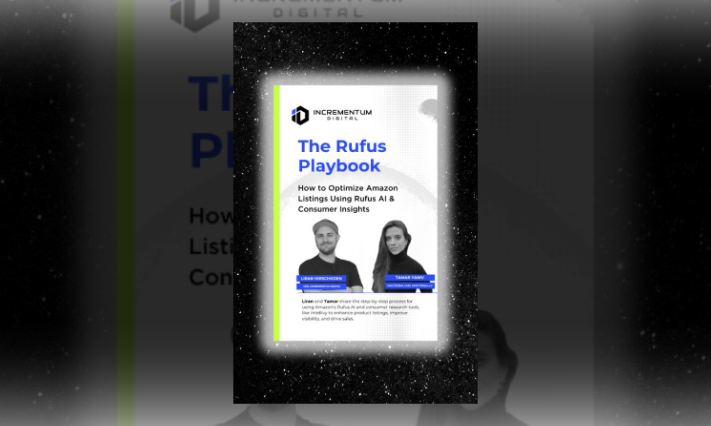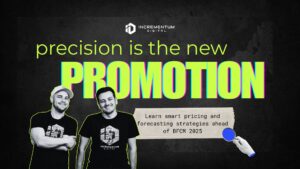Amazon Advertising
20% More Repeat Purchases with Amazon Marketing Cloud: How You Can Do It Too
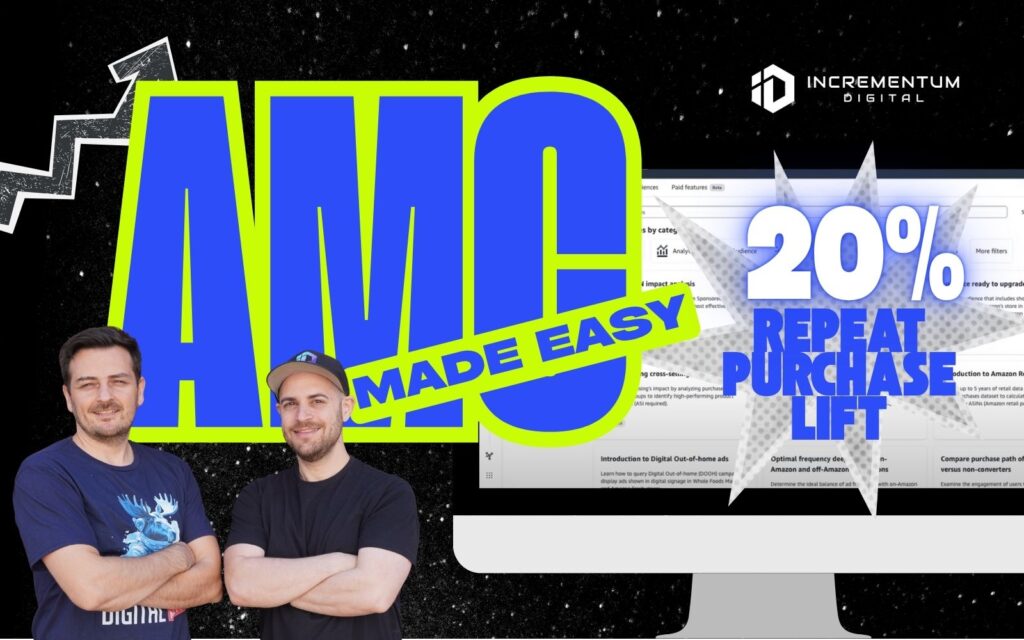
Most brands make Amazon advertising decisions based on surface metrics like impressions, clicks, and ROAS. While those numbers have value, they don’t reveal the full customer journey. As our CEO Liran Hirschkorn and Advertising Director Mansour Norouzi have seen firsthand, these top-line metrics can’t show you if a shopper clicked your ad, compared multiple products, returned days later, and then purchased after seeing a different ad type. Without that deeper view, you’re making decisions without understanding the sequence of events that actually drove the sale.
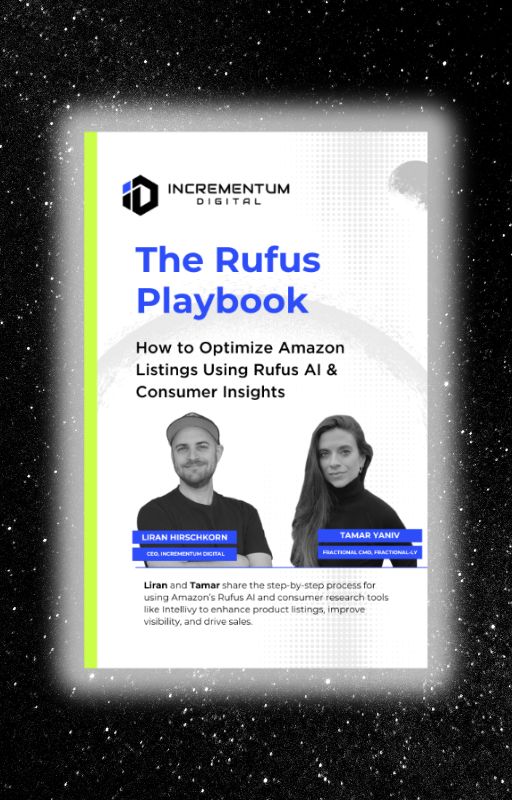
Learn How to Make Listings That Convert in 2025!
Read our step-by-step guide on how to optimize your listings using Rufus AI insights. Sign up for our newsletter and get your copy for free!
Show me howAmazon Marketing Cloud (AMC) changes that. It’s a privacy-safe way to connect every stage of the shopper journey, from first impression to purchase, so you can see exactly how your ads work together to convert customers. In this accompanying guide for our Youtube tutorial, we explain AMC in clear, straightforward terms and show how to turn its insights into measurable growth.
What is Amazon Marketing Cloud?
Amazon Marketing Cloud (AMC) is Amazon’s secure analytics platform, a clean room where brands can analyze detailed, event-level shopper data without ever seeing personal information.
Its purpose is simple: to reveal the full customer journey on Amazon. AMC connects the dots between every interaction, from the first ad impression to a click, other products viewed, and the final purchase (or no purchase at all). By stitching these moments together, it delivers insights you can’t get from standard Amazon Advertising reports.
Why AMC Matters
AMC opens a view into your Amazon customers that you simply can’t get anywhere else, letting you see how different ads, products, and touch points work together to drive sales. This means you can:
- Find audiences most likely to convert or become repeat buyers.
- See how quickly (or slowly) shoppers purchase after first seeing your ad.
- Discover which ad sequences lead to the most sales.
Many brands skip over AMC because it seems complex, but Liran and Mansour prove that some of the biggest wins come from its simplest features. By breaking it down into clear, actionable steps, they turn hidden data into a real competitive advantage for brands.
How Does Amazon Marketing Cloud Work?
At its core, AMC tracks and stores event-level data; every impression, click, add-to-cart, and purchase linked to your ads. Each action is tied to an anonymous user ID, so you can connect multiple interactions from the same shopper without ever seeing personal information. That makes the data both highly useful and fully privacy-safe.
When it comes to analysis, what language is Marketing Cloud? AMC uses SQL (Structured Query Language) to pull and filter data. But you don’t need to be a data scientist — Amazon offers pre-built templates and AI-assisted tools, so you can get valuable insights without writing complex queries from scratch.
What are the Benefits of Amazon AMC?
Amazon Marketing Cloud goes beyond showing ad performance; it reveals why shoppers buy and how each interaction contributes to the sale. This deeper visibility lets you:
- Uncover hidden revenue drivers so you can see the role each ad type plays in acquisition, repeat sales, and brand growth.
- Prove the real impact of your campaigns by measuring incremental sales that wouldn’t have happened without ads.
- Focus your budget where it matters most by identifying the audiences, products, and ad paths with the highest return potential.
- Build smarter, data-backed targeting strategies that increase both efficiency and profitability over time.
Instead of guessing which ads or audiences drive results, AMC equips you with the clarity to double down on what works, and cut what doesn’t, so every decision is tied to measurable growth.
Is Amazon Marketing Cloud a CRM?
This is an interesting yet common question. But no, AMC isn’t a customer relationship management (CRM) system. It doesn’t store customer profiles or contact details, and you can’t use it to directly manage individual communications.
Instead, AMC is an analytics and audience-building tool. It reveals patterns in shopper behavior and complements your CRM by showing you which audiences to target, how they interact with your ads, and what drives them to purchase, making your CRM campaigns more precise and effective.
Who Uses Marketing Cloud and Why It’s Perfect for CPG Brands
The typical users are brands, agencies, and advertisers who want deeper insights into how their marketing drives sales. It’s a favorite among teams that need more than top-line ad metrics; they want to understand the entire customer journey.
For example, Amazon Marketing Cloud is especially powerful for beauty, health & wellness CPG brands:
- Subscription product targeting: Identify and retarget shoppers most likely to join Subscribe & Save programs.
- Cross-selling within a product line: Spot patterns in what products are purchased together and build campaigns to encourage complementary sales.
- Optimizing for high-LTV customers: Find and focus on the customers who buy most often — and spend the most — so you can grow profitable, long-term relationships.
For recurring-purchase brands, it’s a blueprint for sustainable growth.
What Can You Actually Do with AMC?
Amazon Marketing Cloud offers plenty, especially for Health & Wellness brands. It’s not just about looking at numbers; it’s about turning those insights into profitable action. For example, you can:
- Retarget abandoned cart customers with ads that bring them back to complete their purchase — pair it with a special offer for extra pull.
- Create lookalikes of your top subscribers so you can find new shoppers who behave like your most loyal customers.
- Identify cross-sell opportunities between products, such as customers who buy multivitamins and are likely to also purchase probiotics.
- Run branded search win-back campaigns to re-engage shoppers who searched for your brand but didn’t purchase.
Each of these tactics uses AMC’s precise audience-building capabilities to get your ads in front of the right people, at the right time, with the right message.
How to Use AMC to Build and Execute High-Performing Amazon Campaigns
Before AMC can power your campaigns, you need to know how to work with its data. There are three main approaches:
- Templates – Pre-built reports that answer common questions like “What’s my time-to-purchase?” or “Which campaigns drive the most repeat sales?” These require no coding and are a fast entry point.
- Custom queries – For deeper analysis, AMC uses SQL (Structured Query Language). This lets you build tailored reports for unique business questions.
- AI Assist – Amazon now offers AI-assisted query building, helping you generate custom reports without advanced SQL skills.
A simple example: create an audience of shoppers who viewed your product detail page multiple times but didn’t buy — a high-intent segment that’s perfect for retargeting.
- AMC’s pre-built templates make it easy to answer common marketing questions — like which products drive the most repeat purchases — without writing a single line of SQL.
- AMC’s audience builder makes it easy to target high-intent shoppers — like those who viewed your product detail page multiple times but haven’t purchased — without requiring advanced technical skills.
Once you’ve pulled the right insights, here’s how to turn them into measurable growth:
1. Identify High-Value Audiences
Pinpoint the shoppers who deliver the most value to your brand, such as:
- Top 10% of customers by spend.
- Shoppers with three or more purchases in the last 90 days.
- Repeat buyers with short time-to-purchase cycles.
- Customers buying across multiple product lines.
Focusing on these audiences first lets you allocate budget where ROI is proven and build more accurate lookalike models.
2. Build Lookalike Audiences
Model new audiences after your best customers using behavioral data, not just demographics.
- High spenders.
- Loyal repeat buyers.
- Multi-category purchasers.
- Fast converters after ad exposure.
Lookalikes expand reach to prospects with a higher probability of converting while reducing wasted spend.
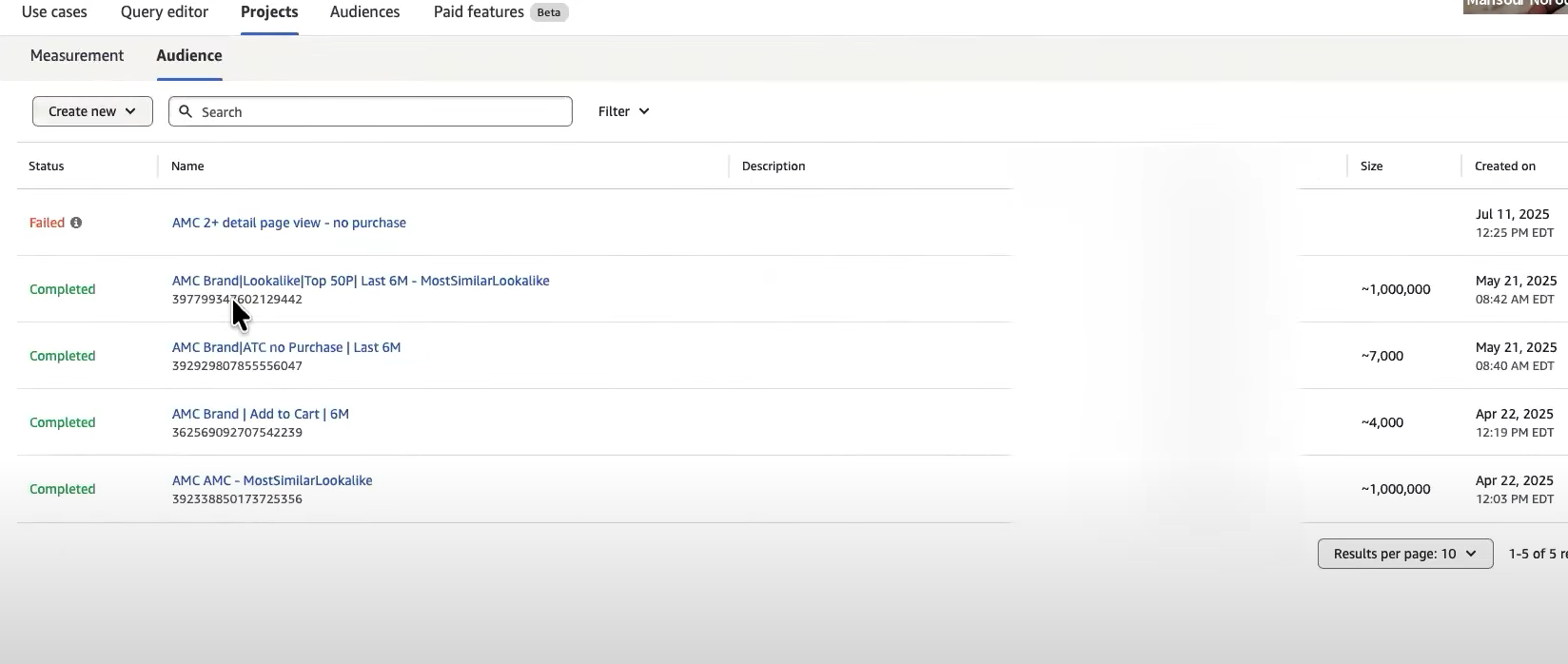
Example of AMC audience projects, including lookalike models and high-intent segments ready for targeting in Amazon Ads.
3. Target with Sponsored Brands and Sponsored Display
- Sponsored Brands for discovery — capture attention early with brand and product showcases.
- Sponsored Display for retargeting — re-engage product viewers, comparison shoppers, and cart abandoners.
This combination ensures visibility from awareness through purchase.
4. Layer Brand Tailored Promotions
Offer targeted incentives (e.g., 10% off) to:
- Slow converters who need a push.
- First-time buyers you want to retain.
- Loyal customers to strengthen affinity.
Aligning promotions with AMC-identified audiences prevents margin erosion from blanket discounts.
5. Measure Incremental Sales
Go beyond attribution to see whether campaigns drove purchases you wouldn’t have captured otherwise.
- Separate ad-driven sales from organic ones.
- Double down on campaigns delivering the highest lift.
- Reallocate spend to maximize ROI.
This process takes you from identifying profitable shoppers to scaling their lookalikes, retargeting effectively, and proving true incremental growth — all within AMC.
Insights in Action: What AMC Reveals That Standard Reports Miss
Once AMC is up and running, the real value comes from the patterns it uncovers, or the “why” behind your performance. These insights act as the raw material for smarter campaigns:
- Time-to-Conversion – Identify how quickly different segments purchase after first seeing your ad, and spot friction points that slow buyers down.
- Purchase Overlap – See which products are frequently bought together, revealing cross-sell and bundling opportunities.
- New-to-Brand vs. Repeat – Understand whether campaigns are winning over new customers or driving follow-up purchases from existing ones.
- Ad Path-to-Conversion – Map how shoppers move between different ad types before buying, so you can refine sequencing.
- Campaign Overlap – Discover when running certain ad formats together produces higher conversion rates than running them separately.
These are the clues that tell you where to focus spend, which audiences to prioritize, and how to design campaigns that convert at a higher rate.
- AMC’s Time-to-Conversion report helps you spot how quickly shoppers buy after first interacting with your ads — revealing both instant wins and delayed conversions that might need retargeting.
- AMC’s Ad Path-to-Conversion report reveals how shoppers move between ad types before buying — helping you refine the sequencing for maximum impact.
- AMC’s Campaign Overlap report reveals which ad format combinations deliver higher conversions — helping you decide when to run them together for better results.
Audience-Building Strategies from AMC
Once you’ve uncovered patterns in AMC, the next step is to turn them into audience segments you can actually target. These proven plays translate raw data into campaigns that drive results:
- Retarget Cart Abandoners – Reach shoppers who added products to their cart but didn’t check out. Keep it broad or focus on specific ASINs depending on the goal.
- Target High-Value Percentile Customers – Build campaigns for your top 5–10% of customers by spend or purchase frequency to ensure your best shoppers see your most relevant offers.
- Build Lookalikes of Subscribe & Save Buyers – Model new audiences after subscription customers to find shoppers with strong repeat-purchase potential.
- Target Based on Multiple Page Views – Focus on shoppers who visited your product detail page more than once without purchasing — a sign of high intent with room to convert.
- Re-Engage Missed Opportunity Audiences – Capture branded searchers who viewed your products but didn’t buy before they drift to competitors.
These segments focus spend where it’s most likely to convert — shoppers with proven value, strong intent, or the highest potential to become loyal customers.
Campaign Applications
Once you’ve built your AMC audiences, the next step is putting them to work across Amazon’s ad formats. Here’s how to translate those segments into campaigns that perform:
- Layer AMC Audiences into Ad Formats – Use your audiences in Sponsored Products for bottom-funnel conversions, Sponsored Brands for upper-funnel awareness, and Sponsored Display for precision retargeting. This ensures your best prospects see the right ad type at the right stage of their journey.
- Adjust Bids for High-Value Segments – Increase bids on your top-spending or most loyal audiences to win more impressions with the shoppers who matter most.
- Combine with Brand Tailored Promotions – Pair your audience targeting with exclusive offers to boost click-through and conversion rates, especially for first-time buyers or lapsed customers.
- Use Creative Variations for Different Buyer Types – Serve urgency-driven messaging to slow converters and benefit-focused creative to fast converters, based on the timelines identified in AMC.
By matching the right audience with the right ad format, bid strategy, promotion, and creative, you can maximize both reach and efficiency, turning AMC data into campaigns that consistently deliver measurable results.
Case Study: How AMC Boosted Repeat Purchases by 20%
Mansour shared a recent example of how AMC insights directly improved retention for a health & wellness CPG brand.
The challenge: The brand was spending heavily on acquisition but struggling to convert first-time buyers into repeat customers. Retargeting was broad, treating all past purchasers the same, and there was no clear view of which ads were driving second purchases.
The AMC approach:
- Identify high-value first-time buyers – Using AMC, Mansour isolated customers with a high initial order value and multiple product detail page views.
- Build lookalike audiences – Modeled new audiences that mirrored the behaviors of these top buyers.
- Activate in Sponsored Ads – Used Sponsored Brands to reach similar prospects and Sponsored Display to re-engage high-value first-timers.
- Layer Brand Tailored Promotions – Offered a targeted discount to encourage a second purchase within a set time frame.
- Measure incrementality in AMC – Verified that the lift came from ads, not organic repeat purchases.
The results: Within six weeks, the strategy increased repeat purchases by 20%, without increasing total ad spend. The same approach was then scaled across other SKUs for compounding growth.
This case is a clear example of how AMC isn’t just about better reporting; it’s about finding and acting on high-value opportunities you’d otherwise miss.
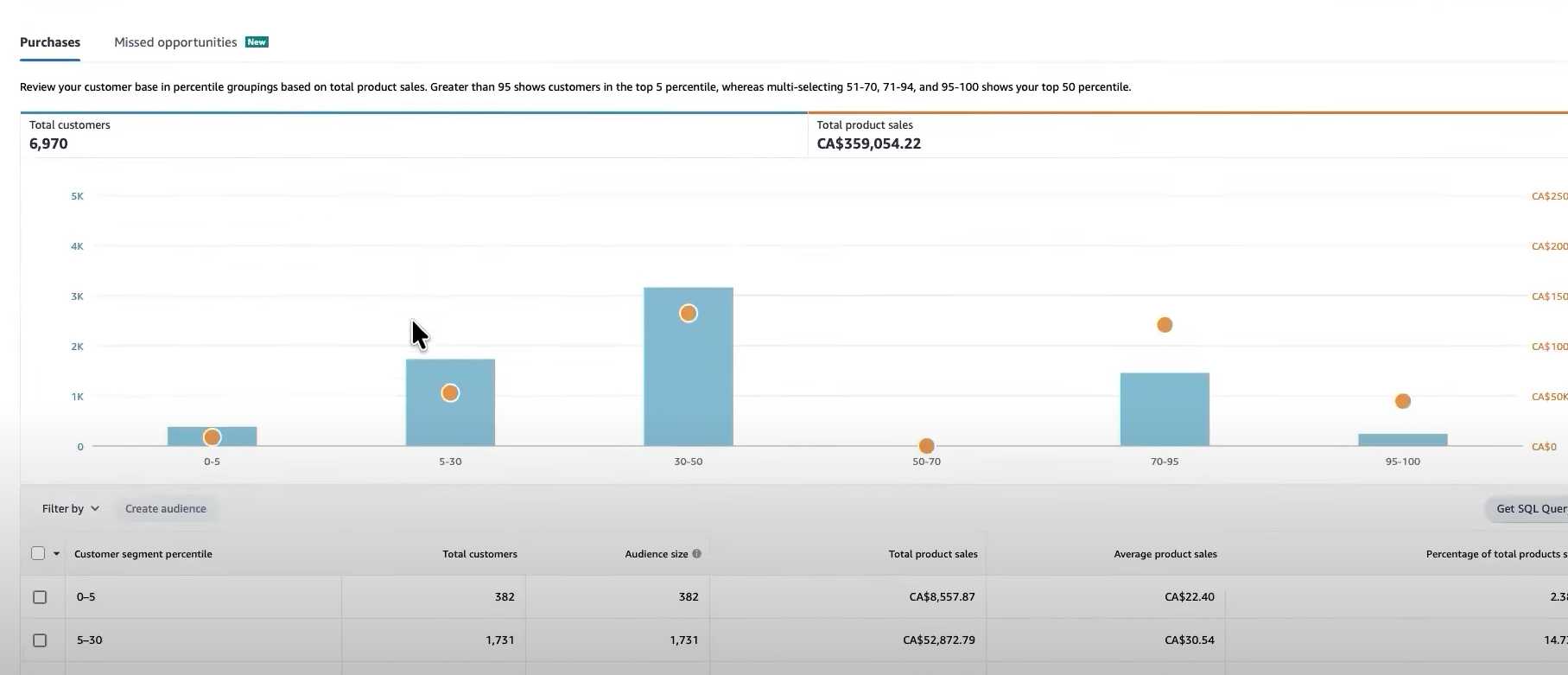
AMC percentile analysis showing the brand’s top-spending customers — the foundation for building high-value audiences in the campaign that boosted repeat purchases by 20%.
How Much Does Amazon Marketing Cloud Cost?
The core Amazon Marketing Cloud platform is free for advertisers with access, giving you the ability to analyze ad interaction data (impressions, clicks, add-to-cart events, and purchases) without paying an additional subscription fee.
Some premium features are available as paid add-ons, such as:
- Organic purchase data to see non-ad-driven sales alongside ad-attributed sales.
- Extended retail history, which can include multiple years of shopper activity.
These upgrades typically cost around $200 per month and are worth considering if you need a full picture of both paid and organic performance or want to run deeper historical analyses.
If you partner with an agency, AMC setup and management are often included in their services. This removes the technical learning curve and allowing you to focus on making decisions from the data rather than figuring out how to access it.
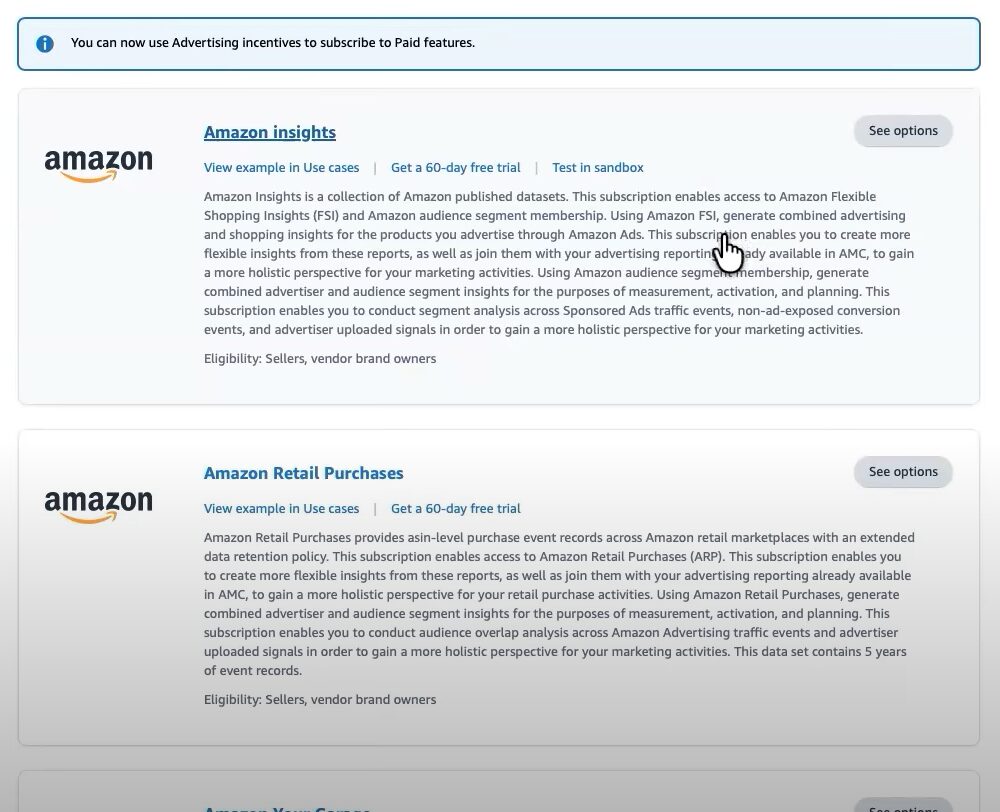
AMC’s paid features — like Amazon Insights and Amazon Retail Purchases — unlock deeper datasets for advanced analysis, such as organic shopping behavior and extended retail history.
How to Access AMC Without the Headache
There are three main ways to get into Amazon Marketing Cloud:
- Through an agency – The fastest, most hands-off option. Your agency handles setup, access, audience building, and reporting, so you can focus on strategy and results instead of technical details.
- Via certain ad tech tools – Some third-party platforms integrate with AMC, offering pre-built reports and audience creation features without requiring direct SQL queries.
- Direct from Amazon – You can request access through Amazon Advertising, but availability varies, and the onboarding process can be inconsistent.
For most brands, working through an agency or a qualified tech partner eliminates the delays and complexity that can come with going direct.
For teams that want to go deeper, Amazon also offers an official Amazon Marketing Cloud Certification. It’s a free learning program that covers everything from basic concepts to advanced audience-building queries, making it easier for advertisers to get comfortable with the platform’s capabilities. While you don’t need the certification to use AMC effectively (especially if you work with an experienced partner), it can be a valuable resource for in-house teams who want hands-on skills.
Why Work with an AMC-Experienced Partner
AMC delivers the biggest impact when insights are turned into precise, revenue-focused action. At Incrementum Digital, we help you skip the trial-and-error phase and move straight to proven strategies, the same approach that boosted repeat purchases by 20% for a health & wellness brand in just six weeks.
If you’re ready to uncover the audiences you’ve been missing and turn them into loyal customers, we’ll help you make AMC work for your growth, without the complexity. Request an Amazon audit here.
LET’S DISCOVER WHAT’S POSSIBLE FOR YOUR BRAND
We’re here to listen and uncover opportunities tailored to your unique goals.
Fill out the form to get started, and you’ll walk away with real insights and actionable recommendations—whether we work together or not.
- HANDS-ON LEADERSHIP
- AWARD-WINNING PARTNERSHIPS
- CUSTOM-BUILT SOLUTIONS





